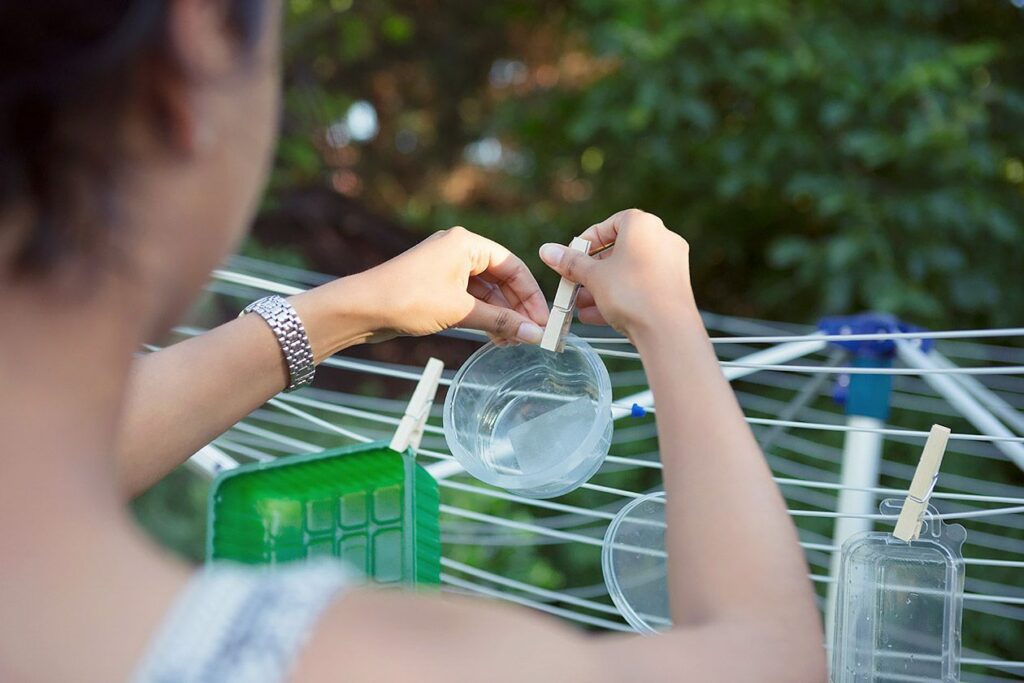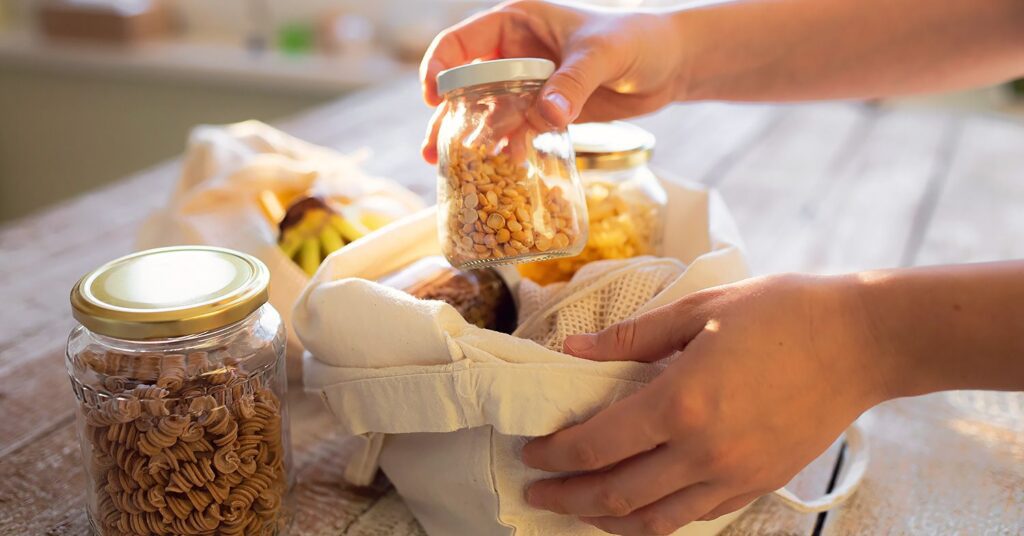An 1829 book titled The American Frugal Housewife, written by Lydia Maria Child, provides hundreds of pieces of advice for cooking, cleaning, preserving food, and making the most out of what a family would already have. In the introduction, Child advises her readers: “Nothing should be thrown away so long as it is possible to make use of it.” How far we’ve come from that.
Our predecessors lived a somewhat-circular lifestyle not by design, but out of necessity. But today, we throw things away when they break, tear, or simply because we don’t want them anymore. We’re creating more trash than we ever have. According to a study by the risk-assessment firm Verisk Maplecroft, the world generates 2.1 billion tons of garbage every year, which would stretch out to nearly 25,000 miles if laid out in a neat line. (That’s just over the Earth’s circumference.)
This landfill waste, which is made up of mountains of food, packaging, old clothes, unwanted electronics, and more, is the third-largest source of human-caused methane emissions, a greenhouse gas that’s 25 times more potent than carbon dioxide. In addition to that, plastic pollution’s meteoric rise during the second half of the 20th century has led to microplastics everywhere—in the oceans, in the air, in the soil, and in our food. Scary, right?
The examples in Child’s book offer just a few examples of the ways in which the domestic sphere (and more specifically, women) has reduced, reused, and repurposed throughout history. Really, up until the early 20th century, neither the rich nor the poor saw worn-out sheets, broken bowls, or empty bottles as garbage.
“Sheets should be turned ‘sides to middle’ before they are allowed to get very thin,” British author Isabella Beeton wrote in her 1861 book, Mrs. Beeton’s Book of Household Management. This meant cutting them lengthways down the center, then sewing together the outside edges. Countless domestic advice books and magazines instructed women to repair, repurpose, donate, or refashion old clothes to keep up with the latest styles. (Not surprisingly, a lot of this domestic work fell on women’s shoulders.)

Can ‘zero-waste’ fix anything?
If you care about sustainability and you’ve spent a minute on social media, then you know what zero-waste means and what the lifestyle supposedly looks like: metal water bottles, reusable utensils, and highly organized cabinets stocked with mason jars filled with pantry essentials. It’s the eco-friendly way of life that’s been on the rise for the past decade: Google searches for “zero-waste” more than doubled between August 2012 and August 2021, peaking in January 2020.
The zero-waste lifestyle feels like it could be a panacea to our non-biodegradable trash problem. You can buy solid shampoo and conditioner instead of the stuff that comes in plastic bottles. You can sign up for a refillable cleaning product subscription, where you’ll be mailed new supplies on the regular. (You might even make your own cleaning products and clean with ratty old towels cut into rags.) And, you can visit a supermarket with a package-free section to stock up on pantry staples.
It’s better for the planet, but—and that’s a very big “but”—it’s not accessible to everyone. You need a lot of time, money, and ideally, both of those things, to do it perfectly. A lot of times, convenience wins out. And, convenience is really why we started wasting so much.
When did taking good care of our belongings so that they last as long as possible become such a foreign concept? And when did wasting so much become both normal and easy to do?

The evolution of throwaway culture
“There’s no one particular date when people started throwing things away,” Susan Strasser, an award-winning historian and the author of the book Waste and Want: A Social History of Trash. This is because there was no one specific historical event that acted as the catalyst for throwaway culture.
We know that the Paris Agreement was signed in April 2016, for example, but if we look at how our habits have changed, then we’ll see a messy timeline of our move from “zero-waste” to mass consumerism. “Older people tend to hang on to habits that younger people don’t adopt, cities adapt faster than the countryside, and the rich pick up these changes faster than the poor,” adds Strasser. Nothing happens at once.
But, the Industrial Revolution during the later 19th century is a good place to look for where the shift towards consumer culture started. With it, came the rise of the middle class and a whole new population of people with disposable income to spend on newly manufactured goods.
Households may have used to save the wood ash from their stoves, refine it into potash, turn that potash into lye, and combine it with leftover animal fat to make soap. But, the process of making soap is time-consuming and labor-intensive (and, yes, they learned that lye is toxic). And, so when industrialization brought soap, and when companies employed advertising tactics that made it desirable, people chose the convenient route.
That isn’t to say that when people stopped making soap that they abandoned DIYing altogether. While some younger people in cities bought the latest manufactured goods, they still took good care of their belongings, particularly their clothes. “People were sewing for many decades after they stopped making soap,” explains Strasser. Upper-class women would send their garments away to the original designer to be reworked in the latest style. Women who couldn’t afford the luxury could buy patterns for the most fashionable new collars and sleeves, so they could remake their old dresses. Clothes were also passed on from rich to poor. The secondhand clothing market was so popular during the 16th century that there’s a Venetian proverb that says: “Never inquire who owns the clothes a person is wearing.”
It wasn’t called “zero-waste” back then, but history provides countless other examples of the ways we wasted less. Kintsugi, the Japanese art of repairing broken ceramics, is said to originate from the 15th century. Before the 1860s, paper was made from cotton, and factories relied on cloth scraps that thrifty housewives sold to peddlers or that were salvaged from the streets by “rag pickers”—lower class men, women, and children—for mere pennies.

Novelty and advertising take over
In the later decades of the 19th century, thanks to industrialization, society began to look a little more like it does today: advertising agencies took the sudden influx of sellable goods and played on people’s FOMO. The US magazine industry exploded in the late 1800s, and periodicals like Ladies’ Home Journal, which ran from 1883 to 2016, were packed with gender-targeted advertisements for made-to-order dresses in the latest fashion, tooth powders, hair removal products, and trendy perfumes.
“People responded to branding and the novelty that technological advancements allowed. Buying things advertised in national magazines became the modern way for young people, people in cities, and rich people to shop,” Strasser explains. “They set the pattern for these changes in daily life. And then that increase in manufacturing capabilities led to more products and more packaging.” (Let’s pause here to reflect how many items we’ve purchased off Instagram…)
With more products came more trash and the need to do something about it because if there was one thing that the forward-thinking consumers didn’t want to be associated with, it was being out-of-style. “The whole concept of newness became central to the way things were advertised,” says Strasser.
That still holds true today; no matter where you go, our daily lives are bombarded with advertisements for new things. People embraced the idea of “out with the old, in with the new.”
And, thanks to the rapid rise of municipal waste collection in the 19th century, people could easily dispose of their belongings rather than hold onto them, or throw them onto the street, as was the case with New York City and many other urban environments.

From the age of plastic into a zero-waste future
Many of the early mass-produced products were packaged in metal or glass, but in 1907, a Belgian chemist named Leo Baekeland would invent something that would shake up consumer culture: the very-first fully synthetic plastic, called Bakelite. It was affordable, durable, and it could easily be mass-produced to make telephones, radios, and even jewelry. And, it was long-lasting to boot. In fact, it won’t biodegrade. (eBay is a treasure trove for vintage Bakelike.)
It was also during these early decades of the 1900s that companies like Dow Chemical and ExxonMobil—two of the biggest producers of single-use plastic today—helped the plastic industry skyrocket. From 1950 to 2015, plastic production increased 200-fold, going from 2 million to 381 million metric tons per year. Plastic—found in water bottles, shopping bags, straws, cosmetics, household cleaning products, utensils, and our clothes—very quickly became ubiquitous. But, plastic isn’t alone: the production of napkins and paper towels led to a shift away from cloth and towards something that could be forgotten about once used to clean up messes. (Heck, disposable paper dresses were even a thing in the 1960s.)
So, that brings us to today and our existing trash problem. World leaders have promised a global treaty to handle plastic pollution, but it remains to be seen what that will entail. Mega-corporations like Amazon, Walmart, and Nestlé make sustainability promises that they consistently fall short on.
People are understandably frustrated with the state of overconsumption and are taking to TikTok, Instagram, books, podcasts, and blog posts to share the little, practical ways that we can consume, and waste, less. Instead of buying soup stock in a carton, we can make it from food scraps. Always have a reusable bag with you, shop from your local farmer’s market, and develop a meal plan every week to cut back on waste. Sustainability influencers are more in demand than ever (for better or worse). We can’t go back completely to the zero-waste lifestyle practices of our predecessors. The 40-plus-hour workweek expected of most of us just won’t allow it unless we’re willing to forgo our time to rest in favor of girlbossing our way into a picture-perfect zero-waste lifestyle.
This brings us back to shampoo bars, plastic-free cosmetics, refillable deodorants, and the countless other zero-waste products that have hit the market over the past few years. Are they truly helping the planet, or are we being given the illusion of choice, considering how fast every single industry (Food, fashion, beauty, furniture… the list goes on) is nowadays?
The reality is, the real responsibility of combatting overproduction lies with corporations and lawmakers. Using more sustainable materials, like recycled polyester or organic cotton is a start for companies like Amazon or Adidas, but they also need to produce less. And, laws need to be put in place to hold them accountable for their carbon footprint.
But that doesn’t mean our consumer choices are powerless. When we support a small brand using deadstock fabric, an emerging beauty company pioneering the new wave of upcycled skincare, or a local zero-waste business, we’re making an impact on that founder’s vision that we can return, at least a little, to the more planet-friendly ways to make the most out of the resources that already exist.


